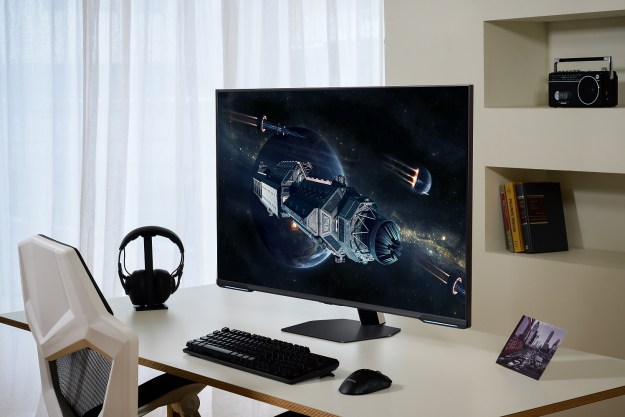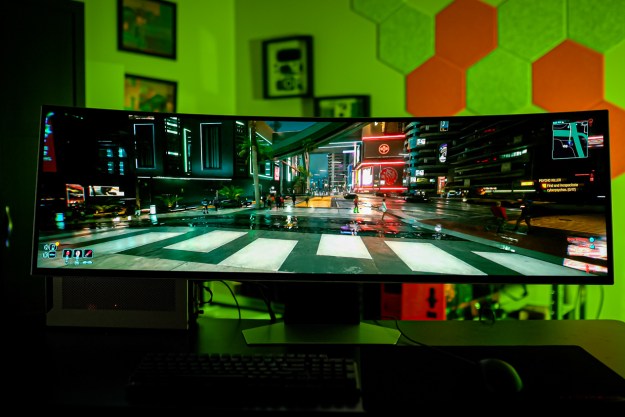
- One of the best OLED displays we've tested
- Unmatched immersive gaming experience
- Speedy 240Hz refresh rate
- Dense settings options
- Full Tizen operating system
- Massive and expensive
- 32:9 doesn't play nicely with everything
Samsung’s current slate of QD-OLED monitors are among the best gaming monitors you can buy, so it’s no surprise that the Odyssey OLED G9 is a great gaming display. What I didn’t expect going into this review is that I’d actually be considering adopting the unique 32:9 aspect ratio that I wrote off for so many years.
At 49 inches diagonally and occupying the space of two 27-inch
Video review
Samsung Odyssey OLED G9 specs
| Samsung Odyssey OLED G8 | |
| Screen size | 32:9 49 inches |
| Panel type | OLED |
| Resolution | 5,120 x 1,440 |
| Peak brightness | 250 nits (SDR) |
| HDR | DisplayHDR True Black 400 |
| Local dimming | 7,372,800 dimming zones |
| Contrast ratio | 1,000,000:1 |
| Response time | 0.03ms (GtG) |
| Refresh rate | 240HzHz |
| Curve | 1,800R |
| Speakers | Yes |
| Inputs | DisplayPort 1.4, HDMI 2.1, Micro HDMI 2.1 |
| Ports | 3x USB-C |
| List price | $1,800 |
Still stunning

The Odyssey OLED G9 looks amazing. The screen looks brilliant, as I’ll get to later, but the design of the monitor overall is stunning. I’m a huge fan of Samsung’s Odyssey design this year, which combines a stark silver frame with just enough flair to let you know that it’s a gaming monitor.
It’s an entirely metal design with a slim silver frame. That’s a huge plus over Samsung’s previous version of this monitor, which had a chunky plastic back that made the display feel extra large. This is still a very big monitor, but the slim frame, along with the subtle 1800R curve, makes it feel more manageable on a desk compared to the previous version.
Something Samsung carried over from the previous version is the CoreSync ring. There’s a layer of diffused plastic around where the stand connects to the monitor that holds RGB lighting. You can set this as a static color, but you can also sync it with what’s on the screen. In a dark room playing Alan Wake 2, the extra bit of lighting did a ton to draw me into the game. Still, the CoreSync ring is fairly dim, so you won’t notice the effect in brightly lit rooms.
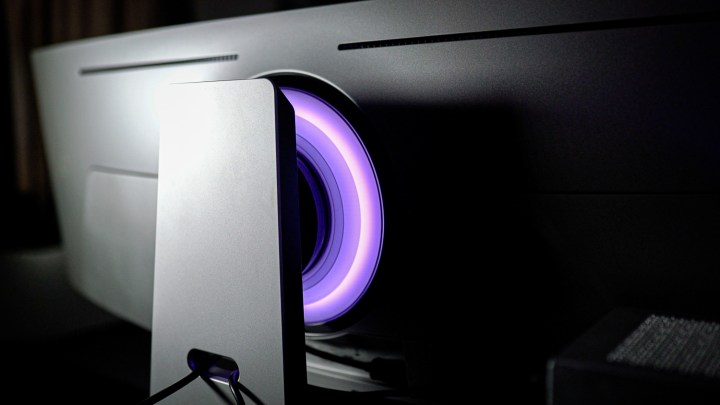
Samsung includes a hefty metal stand in the box that doesn’t take up too much extra desk space. The stand is great, but unsurprisingly, it doesn’t offer a ton of room for adjustment. You have a narrow window for height adjustment and about 15 degrees of tilt, but that’s it. Thankfully, Samsung includes a VESA adaptor in the box, allowing you to mount the monitor for more flexibility in positioning.
Death to mini ports
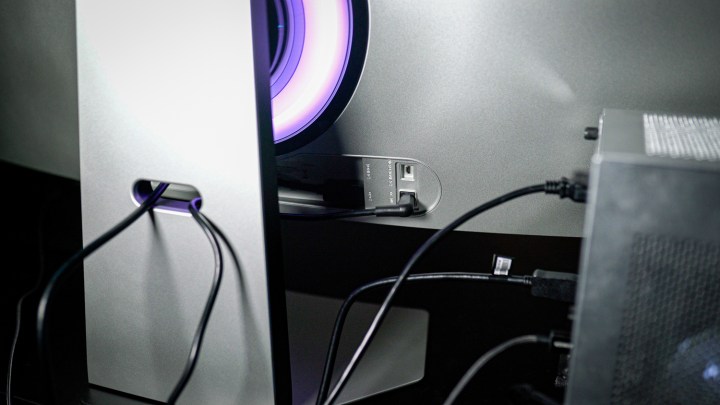
I was a little worried about the Odyssey OLED G9 after reviewing the Odyssey OLED G8, which exclusively relied on mini connections for the HDMI and DisplayPort cables. That’s not the case here. You have full-size
The same isn’t true for the integrated USB hub. You have three USB ports, but they’re all USB-C. Most peripherals aren’t using USB-C cables just yet, so a single USB-A port would’ve gone a long way here. It’s certainly better than the Micro HDMI and Mini DisplayPort connections on the OLED G8, but it’s still something to note.
Image quality

After reviewing Samsung’s Odyssey OLED G8 earlier this year, I wasn’t surprised to see the Odyssey OLED G9 provide jaw-dropping image quality. This is one of the best QD-OLED displays you can buy, with fantastic color coverage, great color accuracy, and the deep contrast and inky blacks that OLED panels are known for.
Let’s get some numbers out of the way. In SDR, the monitor covered 100% of sRGB, 98% of DCI-P3, and 95% of AdobeRGB. For those unfamiliar with color spaces, those are some of the highest numbers we’ve ever recorded, showcasing excellent coverage. The color error was a bit higher than the Odyssey OLED G8 we reviewed earlier this year, coming in a 1.36. That’s fine for color work, though you’d want to put the monitor through calibration for any more serious work.
Contrast is infinite due to the fact that OLED produces perfect black levels, but as we’ve seen with displays like the LG UltraGear OLED 27, the trade-off is peak brightness. For a 10% window, the Odyssey OLED G9 peaked art 237 nits, which is a hair below what we’ve seen with displays like the Alienware 34 QD-OLED. I was able to hit 283 nits in
Switching over to
A productivity monster
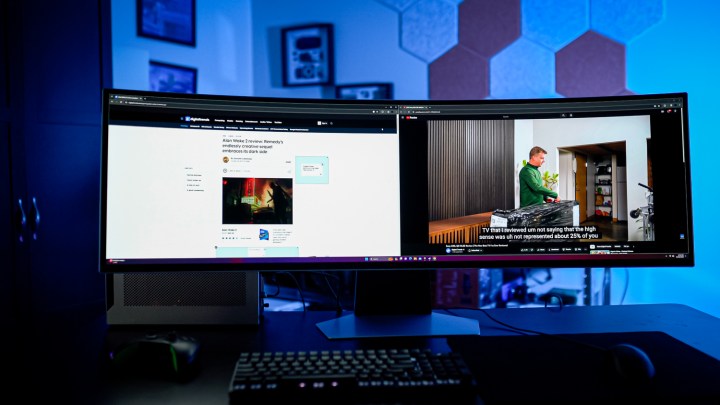
The image quality on the Odyssey OLED G9 is stunning, but you can get that with 16:9
My preferred way to work is on a 21:9 display where I can have two windows side of side, but the Odyssey OLED G9 takes that idea to the extreme. You’re essentially getting two 27-inch, 16:9 displays. It’s two
You can expand this idea further, stacking up windows horizontally to have three or four large views at once. The Odyssey OLED G9 is a massive display, sure, but it actually saves you some space compared to a traditional multi-monitor setup, all while providing the same level of screen space for productivity.
Peak gaming (when it works)
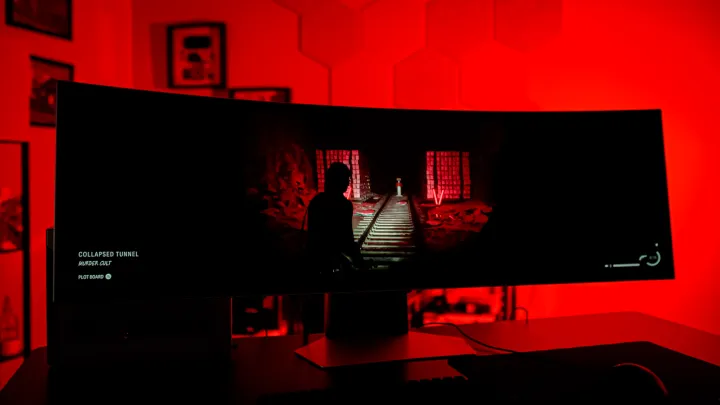
I’ve never had a more immersive gaming experience than on the Odyssey OLED G9. The massive 32:9 aspect ratio captures your peripheral vision and doesn’t let you go. Even at a solid viewing distance, you have no other option but to absorb the game world you’re experiencing. One of the first games I booted up was the recent Alan Wake 2, which I had to turn off after about half an hour because it was too scary in that format.
It’s not remotely close to VR, but it provides that same feeling of immersion. The Odyssey OLED G9 wrestles your senses away, sucking you into games in a way that even 21:9
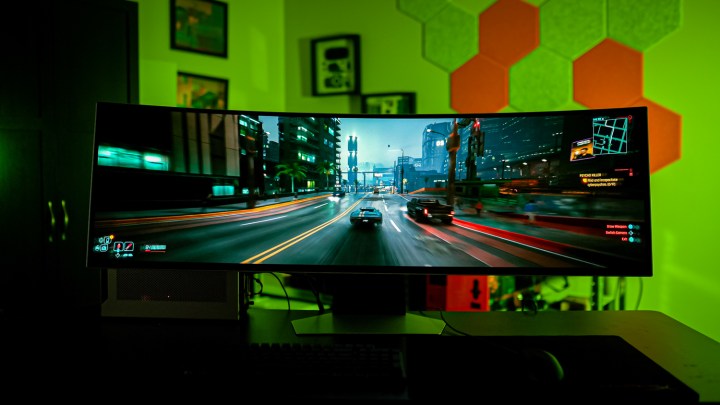
The aspect ratio is what matters most, but the Odyssey OLED G9 has plenty of gaming grunt otherwise. The 240Hz display delivers incredible motion clarity with the ultra-low response times of OLED, making titles like
You should keep in mind how demanding this resolution is, though. The monitor has a 5,120 x 1,440 resolution, and if you do the math, that’s not far off of
Even some popular games like Overwatch 2 don’t support the 32:9 resolution.
When the Odyssey OLED G9 is in prime form, there isn’t any else that’s close to it. The problem is that it often won’t be in its prime form. The unique aspect ratio leads to consistent immersion-breaking scenarios where it becomes clear just how silly playing games with a 32:9 monitor is. Playing Alan Wake 2 was terrifying while I was actually playing, but the moment a cutscene started and the sides of the display became massive black voids, I was brought back down to earth.
It’s not just cutscenes, either. Every time I opened the menu in Marvel’s Spider-Man, the UI looked cramped on the screen as it quickly adjusted its typical 16:9 aspect ratio. There are also plenty of games that simply won’t support the 32:9 aspect ratio. Indie games like Tunic are almost universally locked to 16:9, forcing you to either run the game in windowed mode or sacrifice about half of your screen real estate to the black bars. This can come up in larger games, too, such as Overwatch 2, where 32:9 resolutions aren’t supported.
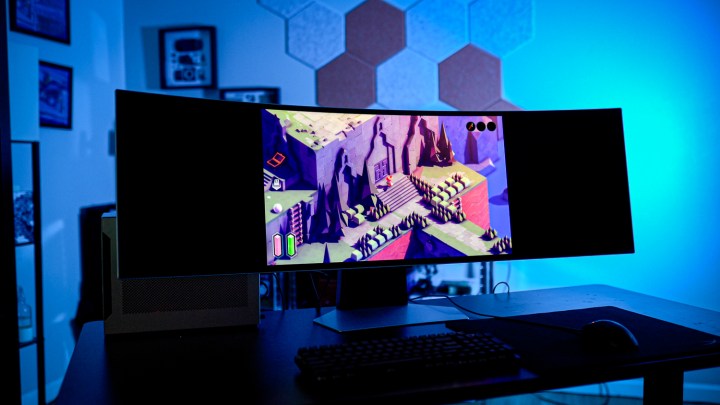
The wide field of view can work against the gaming experience, too. Again, this isn’t VR, but the Odyssey OLED G9 can give you some motion sickness depending on the game. This particularly comes up in games with extreme motion blur and heavy vignetting, where long gameplay sessions can cause some queasiness. That’s something I’ve never encountered with another monitor.
For gaming, the Odyssey OLED G9 is an experience monitor. Spend a few hours with it, and you’ll be floored by the immersion and quality. It’s tougher to settle in for long gaming sessions, though. The black bars for games that don’t support 32:9 are very distracting, much more so than on a 21:9 monitor, so you’ll often have to settle for playing games in windowed mode.
That said, the worst experience you’ll find on the Odyssey OLED G9 is simply what you get on a 16:9 monitor, while the best experience is far ahead what you’ll find with a standard display. And, as I’ll get to next, there are plenty of ways to take advantage of the extra screen real estate.
When 32:9 becomes practical

I just spent a lot of time writing about how 32:9 is impractical for gaming, but with a little bit of effort, it can actually become a huge asset. A lot of that comes down to Samsung Multi View, which lets you split the screen to display different sources. It works great on the Odyssey OLED G9, and it’s a feature you’ll want to take advantage of in a lot of cases.
The main draw here is streaming, of all things. Especially if you hook a console up to the monitor, you can use Multi View to see your game on one half of the screen while your PC occupies the other half, allowing you to see your stream information, capture card details, and more. You don’t have to worry about tabbing out of your game, either; these are two separate sources.
Samsung thankfully allows you to mirror the screen on your phone or laptop.
Even if you’re not streaming, you can connect a console to one half of the screen while your PC occupies the other half with Discord, a video, or Spotify (or anything else you want to run on your PC at the same time). The only downside here is that Samsung doesn’t support a ton of apps from the built-in OS for Multi View. You’re mainly limited to YouTube and Samsung TV Plus. Thankfully, you can add the built-in web browser as a source for Multi View, unlocking basically any app you want.
The biggest problem with this setup is finding something to occupy the rest of the screen with. In those situations where you can’t fill the full 32:9 aspect ratio, you’ll want something else to fill the remainder of the screen, and it’s possible you won’t have a second source (like a console and PC). Samsung thankfully allows you to mirror the screen on your phone or laptop (
Smart TV in your monitor
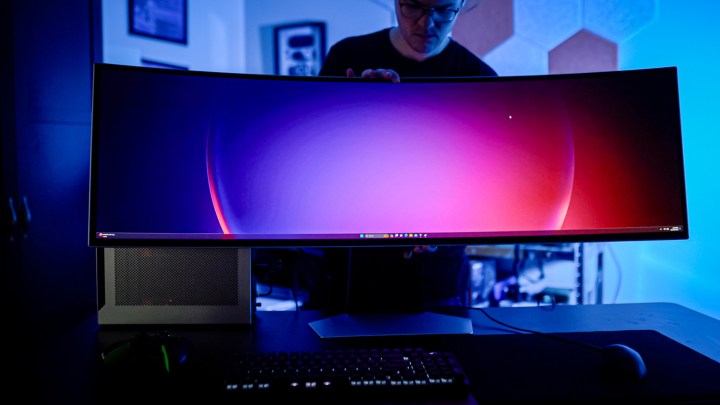
The Odyssey OLED G9 isn’t just a monitor. It includes Samsung’s Tizen OS TV operating system, giving you access to streaming apps like Netflix and
You probably won’t use the built-in apps much — this is a high-end gaming monitor that you’ll probably connect to a high-end

It opens up a ton of display options,as well. You can quickly access things like Samsung Multi View with the remote through the quick access menu, as well dig into picture settings that you wouldn’t normally find on a monitor’s on-screen display (OSD). Even without features like color calibration with supported smartphones, controlling the monitor this way is leagues ahead of using a traditional OSD.
Samsung built some hardware for this experiencem as well. The built-in speakers are surprisingly loud, and they do a great job at positioning audio in games with surround sound. You’ll still want dedicated speakers or
The price matters
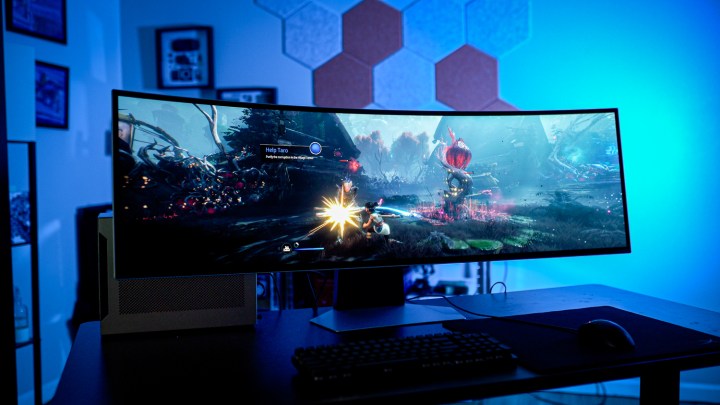
The Odyssey OLED G9 isn’t for everyone. It’s for the most intensive PC gamers, who want peak immersion in games, ample room for productivity, and a feature set that you can’t find anywhere else. The Odyssey OLED G9 delivers on all fronts, all while producing one of the best images you can find on a gaming monitor.
Those looking for those types of PC experiences know that they usually carry some unforeseen quirks, and the Odyssey OLED G9 is no different. As mentioned, 32:9 doesn’t play nicely with all games, and the deep immersion can quickly be thrown off when a cutscene plays. Still, when the baseline experience is simply what you get with a 16:9 monitor, and the Odyssey OLED G9 can scale so much higher, it’s still a remarkable screen.
Samsung asks for $1,800 at list price for the display, but I wouldn’t buy it for that much. It’s not so much that it’s overpriced — there isn’t another monitor quite like this one — but that it frequently goes on sale. At the time of publishing, it’s available for $1,400, putting it in range of some of the 21:9 QD-OLED
Editors' Recommendations
- HP takes on Alienware and Samsung with its 4K QD-OLED gaming monitor
- MSI has some massive QD-OLED monitor news in the works
- Should you wait for the 2023 Samsung Odyssey Neo G9, or buy last year’s model?
- Samsung’s Odyssey OLED 49 arrives cheaper than expected
- Samsung wants you to reserve the Odyssey OLED G9 — without knowing the price




